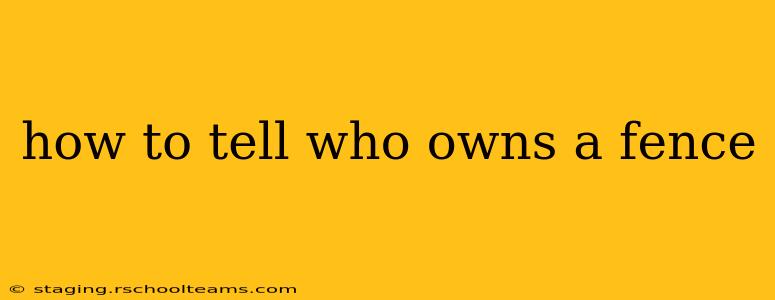Determining fence ownership can be surprisingly tricky, especially when dealing with property lines and shared boundaries. This guide will walk you through various methods to identify the rightful owner, covering everything from simple observation to legal recourse. Understanding who owns a fence is crucial for maintenance, repairs, and resolving potential disputes.
How to Determine Fence Ownership Based on Visual Clues
Before diving into more complex methods, start with a visual inspection. Look for clues that might suggest ownership:
- Property Lines: The most straightforward approach. If you can clearly see property markers (e.g., stakes, survey markers), you can determine if the fence lies entirely within one property or straddles the boundary.
- Fence Condition and Maintenance: A well-maintained fence often suggests the owner resides on the side where it's best cared for. Observe who regularly mows the lawn up to the fence, plants flowers near it, or performs repairs.
- Gate Placement and Access: The location of gates can be indicative of ownership. A gate primarily used by one property's occupants might suggest ownership on that side.
Who Owns a Fence on a Property Line?
This is where things can get complicated. Fence ownership on a shared property line often depends on local laws and agreements between neighbors. In many jurisdictions, the fence is considered a boundary marker, but ownership might not be clearly defined. Some jurisdictions allocate ownership based on who installed the fence, while others might split ownership equally.
What if the Fence is Partially on My Property?
If the fence encroaches onto your land, you have the legal right to have it moved. However, the situation is usually best resolved amicably. Start by talking to your neighbor. Try to reach a mutually agreeable solution, such as moving the fence slightly or compensating you for the encroachment. If a friendly resolution isn't possible, consult with a surveyor or legal professional.
What Documents Can Help Determine Fence Ownership?
Several documents can shed light on fence ownership:
- Property Deeds and Surveys: These official documents clearly define property boundaries. A surveyor can interpret these documents to pinpoint the exact location of the property line relative to the fence.
- Recorded Agreements: If a written agreement exists between previous owners regarding the fence, it should be mentioned in the property deeds or filed with the county clerk.
- Homeowners' Association (HOA) Documents: If you live in a community governed by an HOA, their regulations might stipulate who is responsible for fence maintenance and ownership.
How to Handle Fence Ownership Disputes
If you cannot determine ownership amicably, consider these steps:
- Mediation: A neutral third party helps resolve disputes through negotiation. This is often a less expensive and less time-consuming alternative to litigation.
- Legal Counsel: If mediation fails, consult with a real estate lawyer or land-use attorney. They can advise you on your legal rights and help you pursue legal action if necessary.
- Court Proceedings: As a last resort, you might need to file a lawsuit to determine ownership. This is the most expensive and time-consuming option.
Who is Responsible for Fence Repairs?
Responsibility for fence repairs generally follows ownership. If you own the fence, you're responsible for its upkeep. For fences on property lines, a shared responsibility is often the fairest approach unless a prior agreement dictates otherwise. Always attempt to resolve repair issues amicably with your neighbor.
Can I Remove a Fence on My Property?
If the fence is entirely on your property, you generally have the right to remove it. However, it's advisable to discuss this with your neighbor beforehand, especially if the fence serves as a boundary marker or provides a shared benefit. Removing a fence without informing your neighbor could cause friction and legal problems.
By systematically investigating visual clues, reviewing relevant documents, and exploring various dispute-resolution methods, you can effectively determine who owns a fence and address related issues fairly and efficiently. Remember, clear communication and a willingness to compromise often lead to the best outcomes.
